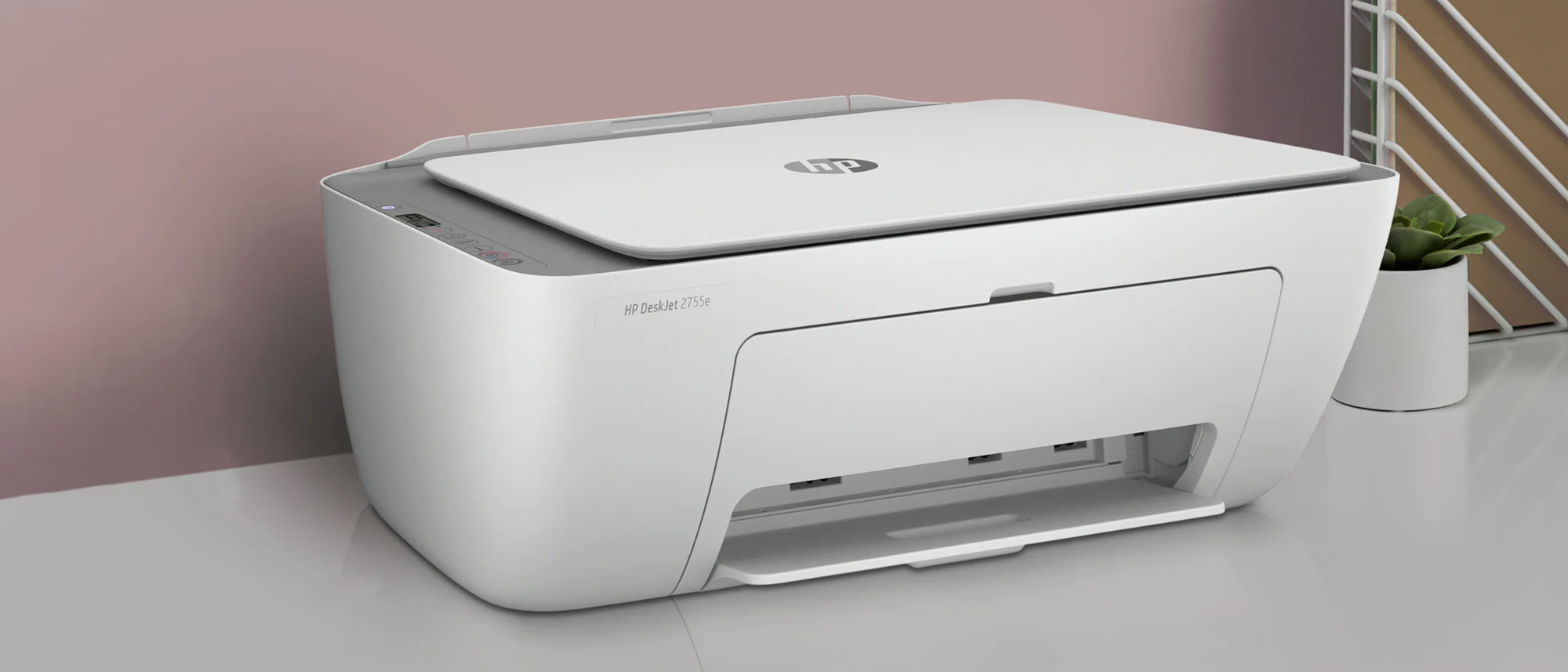Tom's Guide Verdict
The HP DeskJet 2755e delivers high image quality and middle-of-the-road performance, and is a good fit if you don't mind basic software and are willing to sign up for an ink subscription plan to keep ink costs reasonable.
Pros
- +
High image quality
- +
Low printing costs with ink subscription
- +
4-by-6-inch photo printing speed is roughly average
- +
Fax sending mobile (send only) – using HP Smart app
Cons
- -
Ink costs are high without a subscription
- -
Scanning auto crop feature is unreliable
- -
Slower than average printing and copying
- -
Borderless photo printing not supported
- -
Included software is frustrating
Why you can trust Tom's Guide
The small, lightweight HP DeskJet 2755e ($85) offers an attractive set of basic features for an attractive price. It's a multifunction printer that also copies and scans, and you can use a mobile device for faxing if you have an HP Plus account. Built for modest print duty, its input tray holds 60 sheets and the output tray can hold 25 sheets.
This DeskJet offers Wi-Fi and Wi-Fi Direct connectivity. It also has a USB port, but it's very much oriented to online use and cloud storage; it requires an Internet connection for some features. As such, the 2755e may not be the best fit for someone who's periodically offline. More on that later.
The DeskJet 2755e uses two ink cartridges: pigment black and dye-based tri-color. If by chance you only plan to print text documents, the printer supports single-cartridge mode, whereby after setup with the starter cartridges, you can remove the color cartridge.
If you sign up for the HP Plus program, free of charge, you get six months of free ink. This program locks you into using HP's ink cartridges, which are outfitted with a chip to ensure compliance. It also offers updated photo scanning, fax capability from a mobile device, and G Suite connectivity, according to the company. We did not, however, test this program.
HP DeskJet 2755e review: Design
The DeskJet 2755e measures roughly 16.7 x 12 x 6 inches. You'll need extra vertical clearance to raise the scanner lid and raise the input paper tray support, as well as to swing outward the output tray's support. It's compact enough to easily transport—especially considering it weighs just 7.5 pounds.
The single paper input tray is at the back. It's vertically aligned, and you lift up a support to hold the paper in place. The output tray slides out from the bottom of the unit at the front. To better support finished prints, you swing outward a catch from inside the output tray.
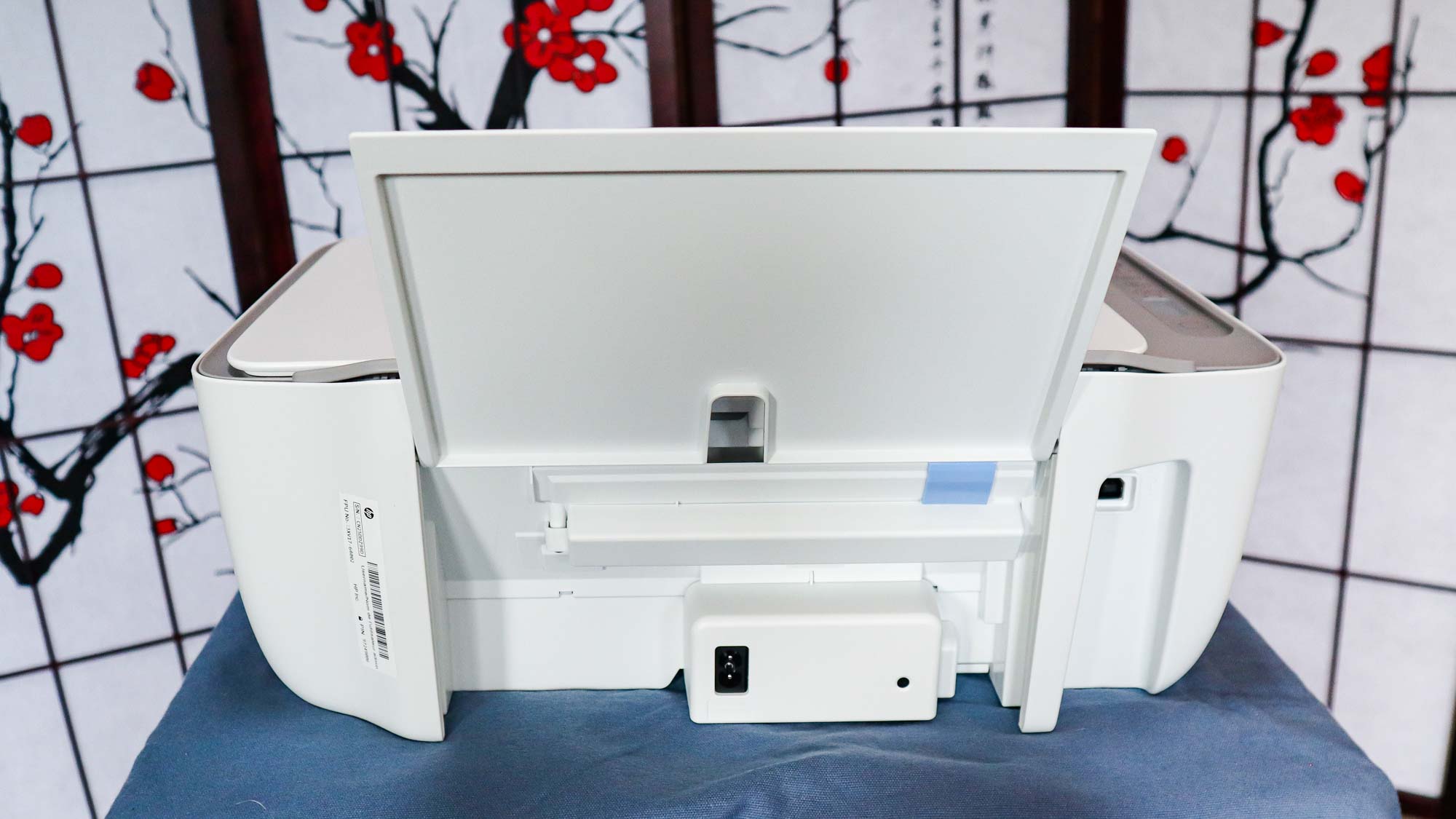
To the left of the scanner glass on the top panel are a few function buttons and a tiny LCD screen that measures 0.5 x 1.25 inches. Standalone operation is limited to making copies, for which there are dedicated buttons for color and grayscale copying. The screen displays only the number of prints or copies, Wi-Fi status, ink levels, and a few other icons. You don't use the screen to navigate settings menus.
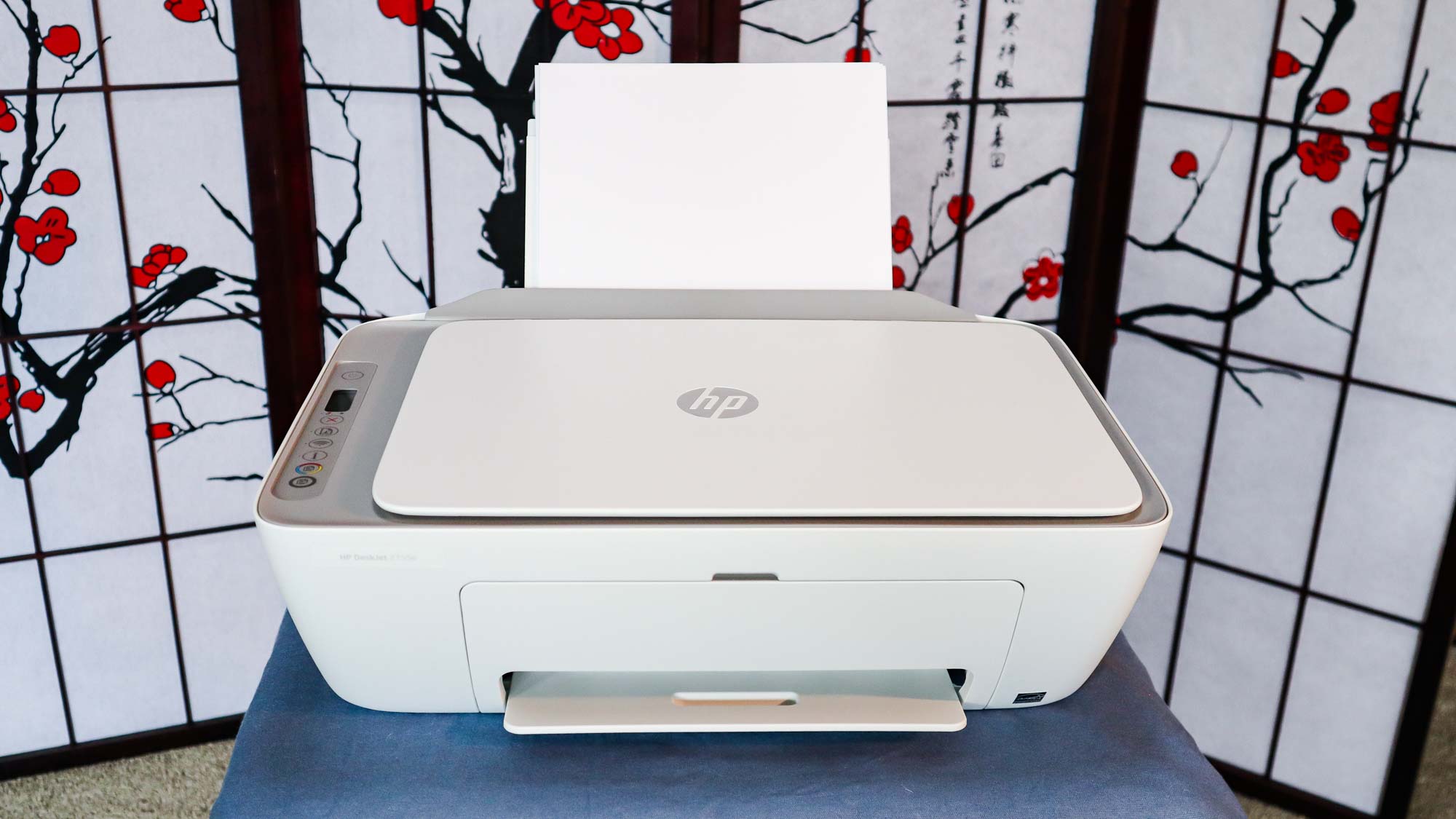
For settings and other functions, you will want to use your PC or mobile device. For example, enlarging or reducing copy size must be done with the HP Smart app.
This basic printer doesn't have a duplexer for making two-sided prints, an automatic document feeder for copying multi-page documents, nor an automatic paper sensor, which some higher-end models offer.
HP DeskJet 2755e review: Print Speed
The DeskJet 2755e printed slower than the category average in our tests. It printed a five-page text document in 39.3 seconds, or 7.6 pages per minute (ppm). By comparison, the average is 8.8 ppm. Similarly, the DeskJet trailed the field average at printing our six-page PDF of mixed text and color graphics. The HP reproduced the document in 3 minutes and 2 seconds, or 2 ppm. The category average is 2.7 ppm.
The 2755e was comparatively slower at making 8-by-10-inch photo prints, taking 7 minutes and 8 seconds to do so, at highest resolution. The category average was a much quicker 4 minutes and 5 seconds.
The DeskJet performed better at making 4-by-6-inch photo prints at default settings. The 2755e made the print in 1 minute and 44 seconds, slightly faster than the average of 1 minute and 48 seconds.
HP DeskJet 2755e review: Copy and scan speed
The DeskJet 2755e copied color documents at slightly slower than average speed, and was less impressive at making black-and-white copies. It produced color copies in 32.4 seconds, on average, compared to the average of 28.1 seconds for competing models. Making black-and-white copies in 25.1 seconds, the DeskJet trailed significantly the category average of 16.1 seconds.
Photo scanning was a little pokey. Capturing an 8-by-10-inch photo in 1 minute and 36 seconds, it lagged behind the category average of 1 minute and 8 seconds. By comparison, the Canon MG3620 ($60) made the same photo scan in just 39.4 seconds.
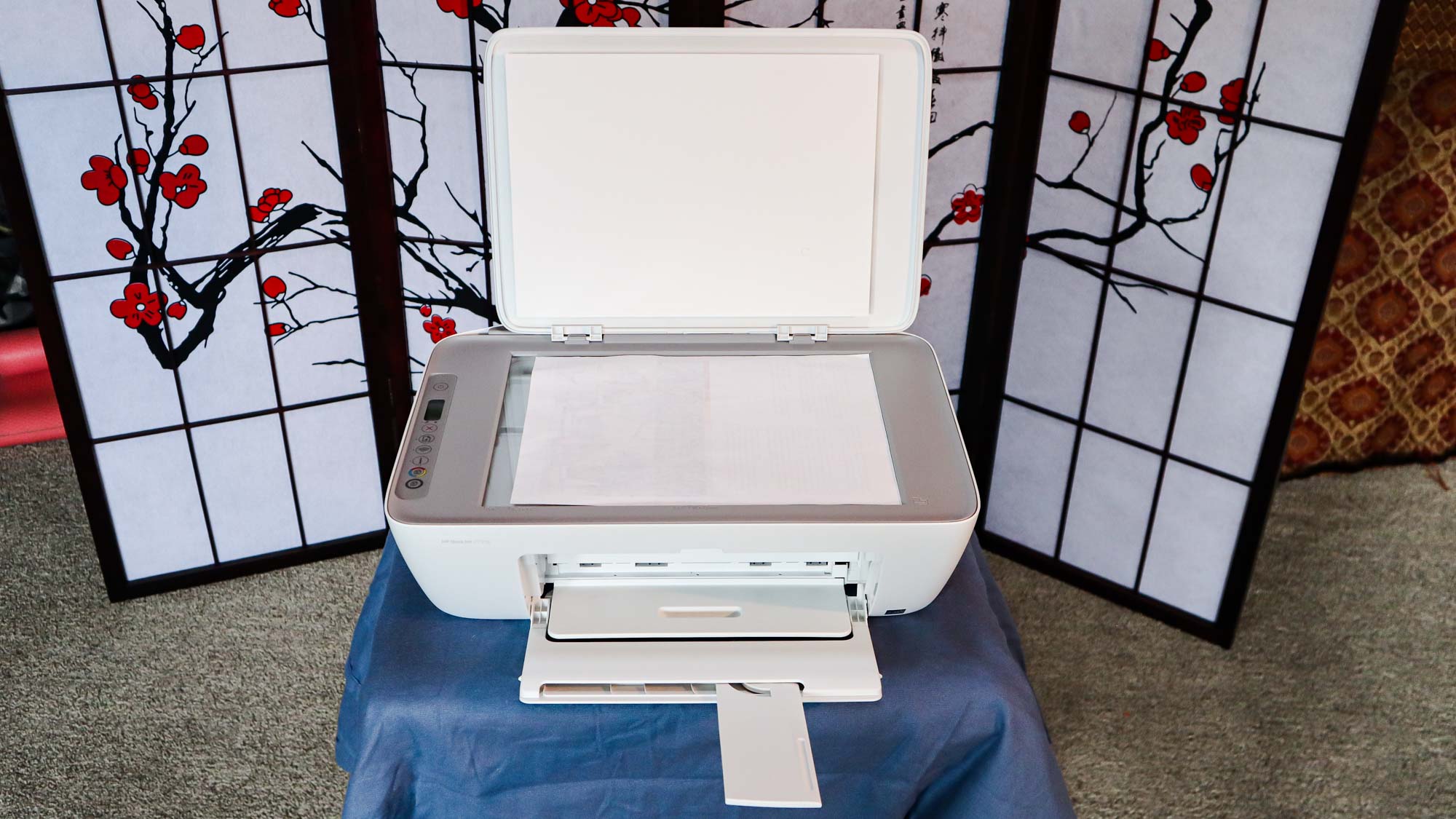
Scanning documents at 300 dpi in black-and-white to PDF format, the HP DeskJet completed a letter-size scan in 19.4 seconds, on average. This was significantly slower than the average of 11.8 seconds, and less than half the speed of the Canon MG3620, which made a black-and-white scan in just 8.9 seconds, on average.
HP DeskJet 2755e review: Print quality
Documents printed with attractive text that looked adequately dark. Letterforms were a little heavy, with some minor errant ink splatter around the edges. By comparison, the HP's text was darker and slightly sharper around the edges than that printed by the Canon MG3620.
The DeskJet also printed attractive graphics. Colors looked natural, transitions were smooth, and no banding was visible. Text in our PDF text document, however, looked a little too heavy and blurry around the edges. For long-term reading, the sharper-looking text documents would be preferable. To ensure software was not the culprit, we printed the PDF both from its native Adobe Acrobat software, as well as from HP Smart, and got the same result.
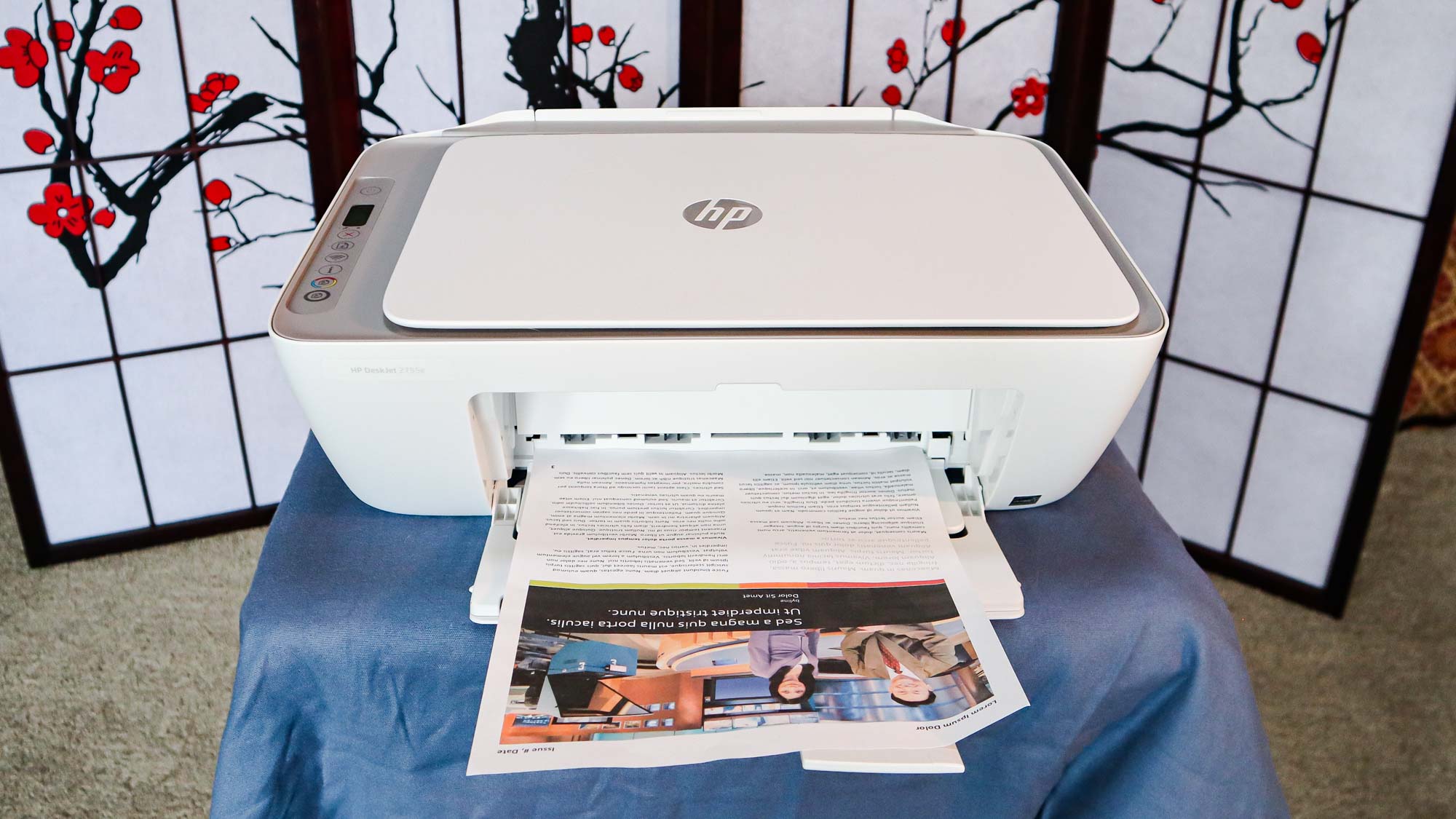
On a couple occasions while making copies, the 2755e pulled 10 or 12 pieces of paper through the unit all at once. While this happened only twice, it does suggest that paper feed problems could occur in the future.
The DeskJet 2755e makes attractive photo prints. The inkjet produced natural-looking colors, smooth transitions, and reproduced fine details well. Across a range of subjects, the DeskJet produced high-quality prints. To note, the DeskJet tends to hype red and yellow hues, creating a warmer look than may be in the original image.
One important caveat about photo prints: Borderless photo printing is not supported. Whether printing from HP Smart on Windows 10, Windows Photos, or from an iPhone 7 using the HP Smart app, there is no option for making borderless photo prints. All photos printed with a border around them.
Similar to its photo prints, documents were reproduced faithfully. Copies of magazine pages were true to the original, reproducing text that looked quite sharp and color graphics that retained the fine details of the original. Colors looked accurate, and when converted to grayscale, the graphics retained the smooth transitions of the original image.
The HP DeskJet made attractive scans, accurately reproducing colors and capturing fine detail in most areas. Shadow areas, however, came out a little darker than in the original and lost some detail.
Scanning photos was not flawless, however, due to the unreliable auto crop feature, which I'll cover in the software section below.
HP DeskJet 2755e review: Ink cost and yield
This DeskJet uses two ink cartridges, a pigment-based black ink cartridge and a dye-based tri-color cartridge. Standard and XL cartridges are available. The starter cartridges will not last long, so be prepared to order more ink very quickly if you don't plan to sign up for an ink subscription plan.
Using standard cartridges, costs per page are an estimated 8 cents (text) and 25 cents (color). Average costs per page for competing models are slightly lower, at 7.8 cents and 21.2 cents, respectively.
Using the XL cartridges will save you money — but the savings is not dramatic. At 10 cents (text) and 22.5 cents (color) per page using XL cartridges, the 2755e lags behind the averages of 6.2 cents (text) and 15.7 cents (color) per page for models that offer high-capacity ink cartridges. However, some of these models offer cartridges of a much higher capacity than this HP's cartridges.
By comparison, using its XXL cartridges with page yields of 600 pages each, the Canon MG3620 delivers costs per page of 6.7 cents for text and 13.3 cents for color.
If it sounds like these ink costs will become burdensome, you might consider an ink subscription plan. Our article, What Is HP Instant Ink?, should give you a good primer for how this works. But, if you'd rather have an algorithm do the thinking for you, you're in good luck. The HP Smart software quickly suggested an HP Instant Ink plan for me after just a few days of printing.
For further comparison of plans by competitors, see our story, HP Instant Ink vs. Canon vs. Epson: Are ink subscriptions worth it?
HP DeskJet 2755e review: Setup and software
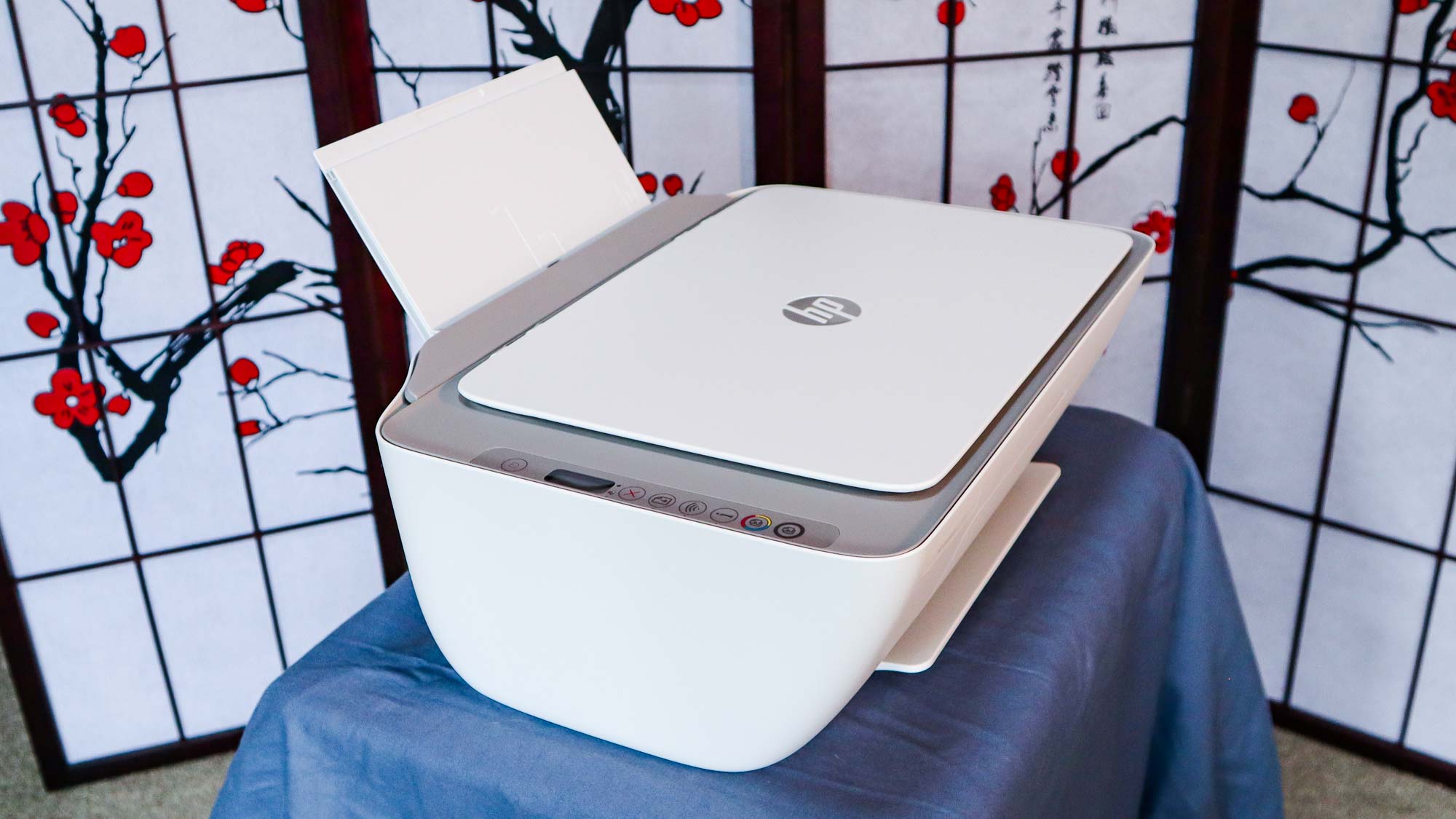
Just as the DeskJet 21755e is online-centric, so is the setup. Printed materials are minimal, and there is no CD-ROM for installing software. You are directed to go online to 123.hp.com to download the HP Smart software. Overall, setup was easy, but I did have a couple hiccups. At first, my Windows 10 PC could not find the printer over USB, and I was directed to turn on Wi-Fi or Bluetooth to complete that task.
Installing the two ink cartridges is simple. You fold down the flap on the front panel to reveal the ink cartridge bay. The cartridges snap into their slot without too much force.
When plugging in the USB cable, my Windows 10 PC found the printer. However, when opening the HP Smart software, it could not find the printer and directed me to turn on Wi-Fi or Bluetooth to complete setup. When this was unsuccessful, I used my iPhone with Bluetooth to get the printer on my network.
The HP Plus program, which is included in the printer purchase, offers six months of free ink. This program locks you into using HP's ink cartridges, which are outfitted with a chip to ensure compliance. It also offers updated photo scanning, mobile fax capability from a mobile device, and G Suite connectivity.
Oddly, although both the printer's LCD and the HP Smart software show estimated levels of each ink, neither reliably displayed a warning that ink is about to run out during my testing. So in my experience, you kind of have to guess, though an HP representative claims this may have been a malfunction as the printer is designed to send low ink warnings via both the display and phone app. However, even though the level indicators showed some ink remaining for my test print job, I ended up with an unattractive photo printed with only yellow ink.
As mentioned earlier, using HP Smart's scanning software on a PC was frustrating due to the unreliable auto crop feature. On multiple occasions, auto crop cut off some — or most — of the image. Scanning a colorful magazine cover, HP Smart mistakenly cropped out a significant amount of the image. Even when selecting 5-by-7-inch as the original size of my photograph, HP Smart still performed an auto crop that included only a small fraction of white space in the bottom corner. In a collage containing two photos, HP Smart selected only one of them, cutting out more than half the total image. In addition, the software doesn't have a built-in crop for 8-by-10-inch photos. But as I found out with 5-by-7-inch prints, it didn't matter. The workaround here is to select "all" and not crop — but this means you will have to crop out the extra white space yourself. If you do much scanning, that is going to get tedious.
If you simply scan using default settings, HP Smart will likely work well for you. However, if you like to use shortcuts for different file types or resolutions, you'll likely find HP Smart too simple. You can't save shortcuts with various resolution or file type settings in HP Smart, nor can you set up shortcuts for saving scanned documents to a folder on your PC — only for saving scanned files to online destinations, such as Google Drive. That means you must set the resolution and file type (PDF, JPG, etc.) every time you scan and save to your PC, which can get tedious.
After performing a scan, HP Smart does not reset for a new scan, which also grew tedious. I had to repeatedly close the "saved file" popup window, and then backspace from the scan preview in order to perform a new scan.
HP Smart's on-screen explanations touted advanced features, such as multiple-item scanning. Unfortunately, this explanation didn't point me to where I would enable this feature. And so, when trying to scan multiple photos, HP Smart only cropped one photo — and did so poorly, leaving out much of the sky of my grayscale landscape shot.
Here's another oddity: If you want to print with HP Smart, you need to open the application and then open a document or photo from there. In other words, from Windows Explorer, right-clicking on a file to see the "open with" list of applications will not show HP Smart in the list. That function is not supported.
HP Smart is also an iOS app, which I tried on an iPhone 7. Using the camera scan function, I took a photo of a photographic print. I had loaded 4-by-6-inch photo paper in the printer. But the iOS app said it was "retrieving paper size info". Swiping upward to check the settings, the app showed it was set to letter-size, but it offered no other paper sizes. One guess is that because the 2755e does not have a paper sensor, this information was not communicated (and I needed to change the setting, perhaps using my PC)--because I did not see a way to add 4-by-6-inch photo paper on the iPhone to my list of choices. Per an HP representative, the iOS app, consistent with AirPrint, only allows the user to select from the paper size loaded in the printer (which had been loaded). Clearly, this didn't work as promised.
So, I tried the scan function in the iOS app. (For both the copy and the scan functions, you are taking a picture of your document). I loaded 4-by-6 paper in the printer — but then I got a print of only part of the image, as if the 2755e was still printing onto letter-size paper. The app offered no setting whereby I could reduce the size of the image on the paper — it defaulted to full page.
Using the camera scan iOS function on a text doc produced passable results. What was laser-sharp text in the original came out demonstrably lighter and fuzzier around the edges, with plenty of noticeable ink splatter. I wouldn't use this feature if the printer is within reach for traditional scanning and copying.
Using the app's copy function, you use an object size icon at the lower right of the screen. You must select this before taking your picture. I found out the hard way, making a letter-size print of a 4-by-6-inch photo, because the copy function default is to copy a letter-size original. For text documents, the copy quality was worse than with the scan function. Text was blurry and the background printed gray, even though I'd taken the picture by a window in bright sunlight, with no reflections from direct light hitting the page.
On the plus side, the HP Smart app offers a helpful zoom magnifier to help you adjust the crop box, which is a nice touch.
Compared to the PC software's bad auto cropping, the iOS app did a better job of cropping dark photos on a white background and text documents on a dark desk. One photo "scan" of a magazine page was poorly cropped, however.
Both the PC software and the iOS app generate repeated sales pitches for the Instant Ink program. This subscription program will likely save you money, so is definitely worth the consideration. In the meantime, however, the solicitations get old. In one case, an Instant Ink sales pitch froze the iOS app and I had to close it.
Neither the HP Smart PC software nor the iOS app offered a low-ink warning. Both apps offer a graphical display showing estimated ink levels, but did not indicate with an exclamation point in a yellow triangle, for example, that a critical level had been reached. As a result, I printed pages that only had yellow ink on a graphic, and absolutely no text on the rest of the page.
HP DeskJet 2755e review: Bottom line
This HP DeskJet offers high image quality and respectable performance for a low price. It's a good budget choice — as long as you sign up for an ink subscription plan.
The lack of borderless photo printing is disappointing, as is the inaccuracy of the auto crop feature when scanning with HP Smart. The software is too limited for sophisticated users, but users with more basic needs will definitely enjoy the high image quality of this bargain DeskJet.
Eric Butterfield is a freelance writer and musician from California. His work has appeared in PC World magazine, CNET, Taproot, and Alter Action — plus Tom's Guide, of course — while his music has appeared in more than 260 TV show episodes for major networks such as NBC, Hulu, BBC America, and more. You can check out his work on Spotify.
